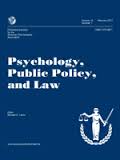
Manipulations that promoted counterfactual thinking led mock jurors to be more certain of the defendant’s liability, award greater damages to the parents, and perceive the agency as more responsible for the child’s death (but this varied by sample type). This is the bottom line of a recently published article in Psychology Public Policy and Law. Below is a summary of the research and findings as well as a translation of this research into practice.

Featured Article | Psychology, Public Policy, and Law | 2016, Vol. 22, No. 4, 349-361
Counterfactual Thinking About Crime Control Theater: Mock Jurors’ Decision Making in an AMBER Alert Trial
Author
Mauricio J. Alvarez, University of Nevada, Reno
Monica K. Miller, University of Nevada, Reno
Abstract
Crime control theater refers to policies enacted as a response to a moral panic, based on folk beliefs about crime; such policies are perceived as more effective than they really are. AMBER Alerts are one example of crime control theater. Beliefs that AMBER Alerts can protect children might lead people to develop counterfactual scenarios in which they think “if only” an AMBER Alert had been issued (or issued earlier) the abducted child could have been rescued. This study evaluated the influence of case characteristics conducive to generating counterfactual statements (e.g., abnormality, controllability) and juror education on mock jurors’ decision making in a trial involving parents who are suing a law enforcement agency for negligence following the agency’s alleged failure to rescue their abducted child. Manipulations that promoted counterfactual thinking led mock jurors to be more certain of the defendant’s liability, award greater damages to the parents, and perceive the agency as more responsible for the child’s death (but this varied by sample type). Conversely, educating jurors on the limitations of the AMBER Alert system resulted in lower certainty of the agency’s responsibility and nullified the effect of AMBER Alert issuance on damage awards. The effects of abnormality and controllability on participants’ decisions were mediated by generating counterfactual statements. Findings indicate that counterfactual thinking might influence individuals’ support for crime control theater policies. Specifically, individuals exposed to aversive events (e.g., abduction and death of a child) might be motivated to support policies (e.g., AMBER Alerts) that could have prevented the aversive event.
Keywords
Risk assessment, age, test bias, disparities, sentencing
Summary of the Research
AMBER Alert, counterfactual thinking, juror decision making, crime control theater, expert testimony
Translating Research into Practice
“The effects of the Procedure manipulation suggest that individuals generally attribute greater fault to law enforcement when they fail to rescue abducted children as a result of individual officer’s error, compared to when they fail to rescue abducted children while following established procedure. Also, educating participants led to lowered perceptions of responsibility and eliminated differences in damage awards based on the issuance or nonissuance of the AMBER Alert. These findings indicate that people believe that AMBER Alerts are effective. These beliefs about the effectiveness of AMBER Alerts can result in public backlash against law enforcement agencies that do not issue AMBER Alerts, even when this is a result of policy guidelines (e.g., there was not enough information to issue an AMBER Alert)” (p. 357).
“The effects of expert testimony demonstrate that education can be a powerful tool to reduce popular support for crime control theater policies. This occurs because education challenges the factors that make these policies popular, which limits individuals’ certainty that crime control theater policies “save the day.” In the context of AMBER Alerts, individuals might be less supportive of the AMBER Alert system after learning that a) AMBER Alerts are considerably less effective than most people think, and b) AMBER Alerts focus on stranger abductions even though familial abductions are more common. This lower support, in turn, might facilitate the development of alternative policies which can more effectively address the issue of child abduction. Alternatively, lower support might result in lower opposition on redirecting funding from the AMBER Alert system into programs designed to address other hazards which are more common (e.g., children deaths due to choking). A similar effect might occur with other crime control theater policies: as individuals are educated on the limited effectiveness and incorrect assumptions about crime perpetrators and victims, support for crime control policies would wane which in turn might allow for the development of more effective policies to address social issues” (p. 357).
“The findings of this study indicate that circumstances conducive to generating counterfactual statements can influence mock jurors’ verdict certainty and damage awards. Given beliefs about the effectiveness of the AMBER Alert system, it is likely that the expert witness’ testimony challenged mock jurors’ beliefs. Despite this challenge, mock jurors were able to incorporate the expert witness’ information into their verdict decision. This suggests that, at least for certain topics, jurors’ preexisting beliefs might be successfully challenged by expert witness’ testimony” (p. 358).
“In the context of educating jurors about the limited effectiveness of AMBER Alerts, the counterintuitive nature of the facts (i.e., AMBER Alerts are perceived as effective, but are not) suggests that these facts are beyond the jurors’ knowledge. Similarly, cross-examination of the involved parties seems unlikely to result in this knowledge being imparted to the jury, as both the plaintiffs and the defendants probably share the general perception of AMBER Alerts as effective. The knowledge presented by an expert witness on the issue of AMBER Alert effectiveness is arguably highly relevant to a case in which the issuance or nonissuance of an AMBER Alert is linked to the death of a child, particularly given that the evidence suggests that AMBER Alerts have generally little impact on the outcome of child abductions. Finally, the findings from the present study on the effect of juror education suggest that jurors generally accept the expert’s testimony and adjust their decisions accordingly, an effect which would not occur if jurors were confused by the testimony” (p. 358).
Other Interesting Tidbits for Researchers and Clinicians
“The use of mock jurors raises concerns about verisimilitude of the study (i.e., whether participants would find the case believable). Verisimilitude can impact mock jurors’ decision because a lack of verisimilitude can lead participants to pay less attention to the study materials because they do not represent a “real” trial. As a result, the findings might be different to what occurs in real trials. Similarly, the use of mock jurors raises concerns about consequentiality (i.e., because it is a mock juror study, there are no “real” consequences to participants’ decisions. This can lead participants to pay less attention to their answers, or to provide random answers because there is no “real” defendant who is affected by the participants’ decisions. Finally, the study evaluated participants’ responses at the individual level, rather than at the group (i.e., jury) level. This can influence participants’ responses because group processes (i.e., deliberation) can result in jurors changing their individual assessment of the case, particularly if they find themselves as part of the minority opinion” (p. 358).
“The findings of this study showed how counterfactual thinking can impact mock jurors’ decisions in cases involving a crime control theater policy (i.e., AMBER Alerts): circumstances which are conducive to counterfactual thinking result in greater punitiveness toward the Sheriff’s Office. In line with previous research results provided further evidence that individuals can be educated about the low effectiveness of crime control theater policies. Future research should expand on these findings by evaluating how counterfactual thinking and education about the limited effectiveness of crime control theater policies impact support for crime control policies beyond the context of a civil trial, for example in evaluating public support/opposition to legislation implementing or dismantling crime control theater policies. In addition, future research should also evaluate the impact of personal relevance on support for crime control theater policies and on openness to education about the effectiveness of crime control policies. For example, are parents more supportive of AMBER Alerts, compared to nonparents? Are parents less likely to decrease support for AMBER Alerts after learning about their limited effectiveness, compared to nonparents? Research on the impact of personal relevance could help identify individual characteristics that make individuals more or less likely to support crime control theater policies” (p. 359).
Join the Discussion
As always, please join the discussion below if you have thoughts or comments to add!






